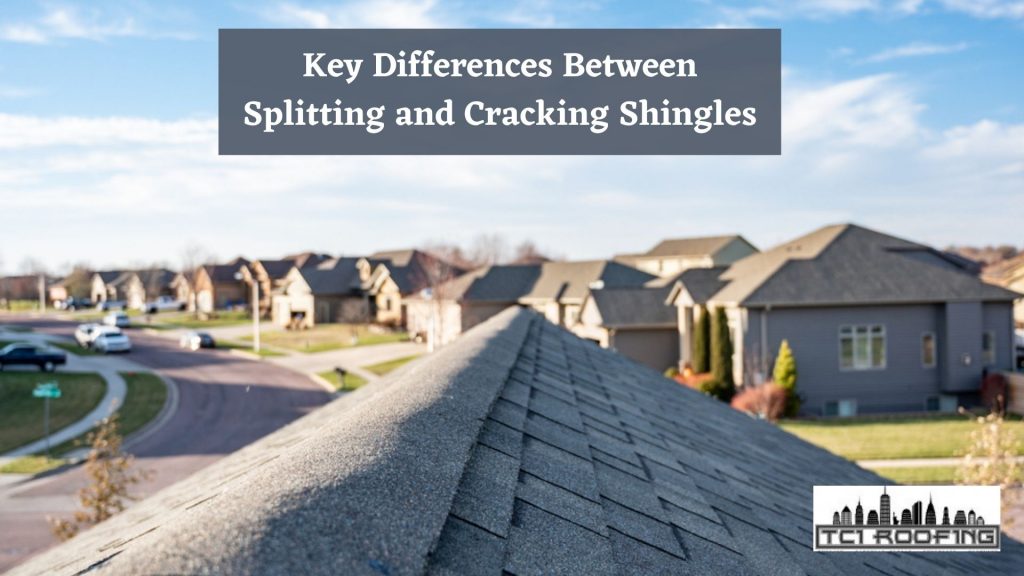
Shingles are the roof shingles that cover your house, and they come in a variety of colors, shapes, and sizes. In order to make shingle installation go as smoothly as possible, you will need to know the difference between splitting shingles and cracking shingles. Splitting shingles are cut with a saw so they can be installed on top of other shingles without overlapping them. Cracking shingles work best when laid side by side because their width is equal to the distance between two adjacent rows of nails or screws on the sheathing board beneath it.
Splitting Vs. Cracking
The aging and wetness of organic or fiberglass shingles cause cracking. Excessive fillers are also frequent in asphalt mixes. However, if you recently installed a new roof, cracking could indicate that your shingles are fragile and low-quality. Splitting occurs as a result of temperature variations. It’s worth noting that shingles grow in warm weather. As a result, the joints shrink in size. When it’s cold outside, joints tend to swell.
Lines run over the surface of each shingle in both split and fractured shingles. On the other hand, splitting is defined by deep gaps that run the length of a shingle. Shingle cracks, on the other hand, are usually only a few millimeters deep.
In terms of depth, splitting and cracking are different. They also put the roof in various states of danger. Splitting produces a water channel that travels right to the roof’s most vulnerable areas. On the other hand, cracking weakens the entire surface of the shingle, potentially causing it to bend or get dislodged later.
TCI Roofing Repair Contractor Company Bronx NY is a roof service expert that provides quality services. check our website at RoofingBronxny.com
CRACKING
Crack shingles are commonly caused by moisture or the age of the roof. Roof aging is more likely to break organic or fiberglass shingles, while excessive fillers in the asphalt mix can also create this problem. If your roof is brand new, the fractures could result from a faulty mat or subpar shingles. Moisture or evaporation can also cause the shingles to lose volatiles. As a result, the asphalt shingles become dry, shrink, and crack. The main goal of the volatiles, which are compounds added to the asphalt mix, is to make the shingles more flexible and water-resistant. If the volatiles in your asphalt shingles were insufficient, your roof would be less flexible and more prone to cracking.
SPLITTING
The cause of roof shingle splitting is temperature changes, occurring in a diagonal pattern or randomly throughout the roof. The shingles expand, and the joints between them shrink as the temperature warms. The joints swell when it gets cold outside.
The bridging shingles are stressed as the roof shingles that connect the underlying seams shrink. The adhesive strips lose their effectiveness due to these conditions, leading the damaged shingle to separate. Your roof is subject to leaks and wind damage if your asphalt shingles have split.
Common Causes
Asphalt shingle roof splitting and cracking, whether regular three-tab shingles or designer shingles, is more than just a cosmetic concern. If not repaired by a roofing expert, Split components can produce holes in the shingles, allowing rain to penetrate and cause leaks. A roof with cracked or broken shingles is vulnerable to rainfall intrusion and should be repaired by your roofing professional as soon as possible. The following are some of the most common causes of cracking shingles and thermal splitting.
High-speed winds
High-speed winds are a huge factor for both situations as well. Modern asphalt shingle roofs are designed with wind resistance that has reinforcing adhesives at the shingle edges. However, sometimes the wind may be too strong and lift these shingles, and folding may occur. It is when cracks on the granule layer begin to appear and eventually cause splitting.
Thermal expansion
Temperature variations cause all substances to expand and contract. However, some develop and employ more than others. This is why, in enabling the thermal expansion, extensive areas made up of several parts concrete slabs, floor tiles, and roofing shingles, to mention a few – must be erected with gaps between them. This helps prevent cracking on asphalt shingle roofs by preventing the shingle pieces from exerting pressure on each other as they expand. Fortunately, thermal expansion cracking or splitting may be avoided by dealing with a professional roofer, and quality or installation warranties can assist reduce the cost of repairs.
Faqs
- Is it true that only 3-tab asphalt shingle roofs experience thermal splitting or shingle cracking and tearing?
No, both traditional 3-tab shingles and laminated asphalt shingle roofs can experience thermal splitting or rips.
- Thermal Splitting Cracks in Fiberglass-based Asphalt Roof Shingles: What Causes Them?
It’s possible that even if the shingles fulfill the Standards, the Standards themselves are flawed. Asphalt roof shingle regulations, for example, united these issues for a time:
The shingle substrate was allowed to be a thin fiberglass mat that was not tear-resistant enough.
The wind uplift prevention bonding adhesive was overly firm, resulting in the shingles forming almost a single continuous surface with insufficient movement to respond to significant temperature changes without ripping the bound surface.
Why are my shingles cracking?
The most common cause of shingle cracking is shingle aging or other environmental conditions. However, shingles that have not been correctly fitted are more likely to crack due to this flaw. In addition, thermal splitting and poor goods cause shingles to break.
What is a shingle split?
When a shingle splits into two or more pieces, this can be caused by strong winds, brittle shingles that have aged over time, or improperly put shingles. And, thermal splitting occurs as a result of the shingle contracting and expanding when the temperature changes. If your property is subjected to high-temperature changes, thermal damage such as this may occur, whether you have traditional 3-tab shingles or laminated asphalt shingles.
